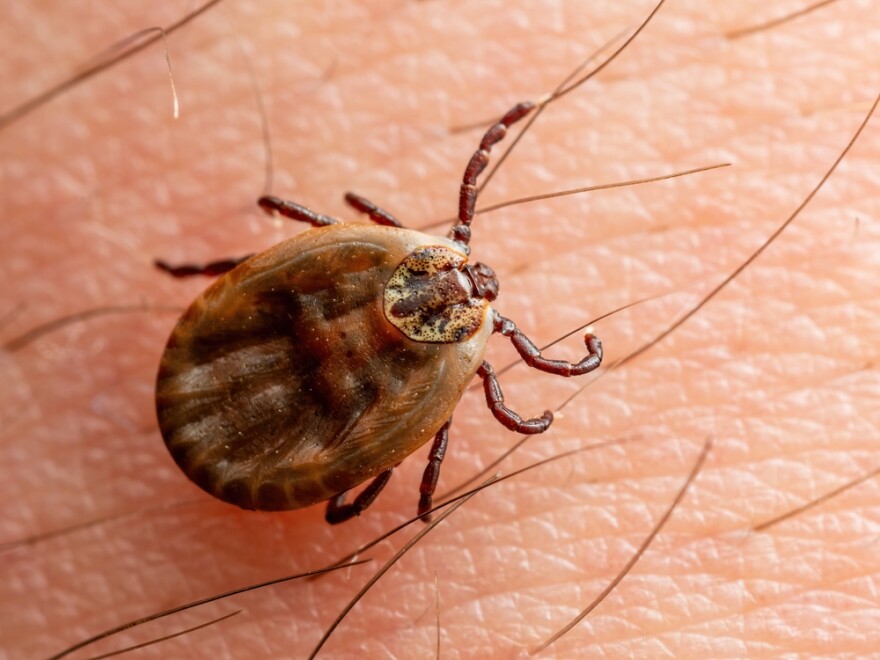Tick activity increases in early spring through summer. However, recent lab data indicate people across Texas have brought in more ticks for testing this season than in years past for illnesses such as Lyme disease and Rocky Mountain spotted fever.
The Tick-borne Disease Research Lab at UNT's Health Science Center is offering free testing for those diseases.
Dr. Michael Allen directs the Lab. He spoke with KERA's Sam Baker about what's behind the increase in tick activity.
Dr. Allen: A mild winter, a relatively wet spring and summer, and not too oppressive heat can all lead to an increase in the survival of ticks over the winter and into the summer.
So, it could be local weather conditions that are leading to an increase in ticks. They have a two-year life cycle, so two years of relatively mild winters and wet and cooler summers can lead to a large increase in the numbers.
Baker: Is there one tick-borne disease that's trending higher than others?
Dr. Allen: Lyme disease is the biggest concern. We're approaching about half a million cases a year in the United States.
We don't have Lyme disease in Texas at any concerning levels, but people travel. We had a tick submitted just last week that was positive for borrelia burgdorferi, the causative agent of Lyme disease. The submitter had traveled to an area that is endemic for Lyme and brought that tick back with them.
So, it's important when you talk to your physician, or you're submitting a tick sample to our lab, please let us know where you were and where you possibly picked this up because that can change the type of pathogens that it's carrying and may lead us to look for different things that we might not ordinarily look for.
Baker: Were you likely to encounter a tick?
Dr. Allen: Most of the time it's in a rural setting, or if you're in the city and you take your dog for a walk down by a water creek or something that has typically those areas will have taller grass closer to the water. And it's that edge area where you can be exposed more to different kinds of ticks.
So, if you are staying on a trail, for example, with relatively low grass, you're at much less risk than you are if you get out into a field with tall grass. Or up under the edge of the canopy where the trees are, you'll be exposed to more in those kinds of areas.
Baker: What else do you do to prevent tick bites?
Dr. Allen: Well, prevention is really the key. Many of the things we can do for mosquitoes, such as spraying with DEET-type repellent, also work for ticks. You can also use clothes that have been treated with permethrin, which is an insect repellent. This works for tick as well. And so prevention is the most important aspect of all of this.
Baker: But should you get or come in contact with a tick, what should you do?
Dr. Allen: Well, if the tick is just crawling on you, it's not a problem. It has to bite you and sometimes stay attached for a day or two before it can effectively transmit any other pathogen that it might be carrying. Not every single tick is carrying a pathogen, so it may be that there's no issue at all.
But for citizens in the state of Texas, we offer a free service in which you can submit your tick to the Department of State Health Services in Austin, and they will forward it to us for testing. And we can look at that tick and determine if it's carrying any potential pathogens that should be of concern.
If you find a tick on your person, you should remove it as close to the head as possible, preferably with something like tweezers. You don't want to mash it and inject more tick fluid into your body. You want to cleanly pull the tick away and remove it.
And monitor yourself for any signs of flu-like symptoms, fever, or any kind of rash for a few weeks following that. And if you show any of these symptoms, you can take the tick to the doctor or take a picture of it and discuss with your physician that you were exposed to a tick and see if that aligns with your symptoms and with any tick-borne disease.
RESOURCES:
Tick talk: How to spot, avoid, and remove ticks in Texas
Tick bites are sending more people to the ER this summer. Experts explain why.
Copyright 2025 KERA

